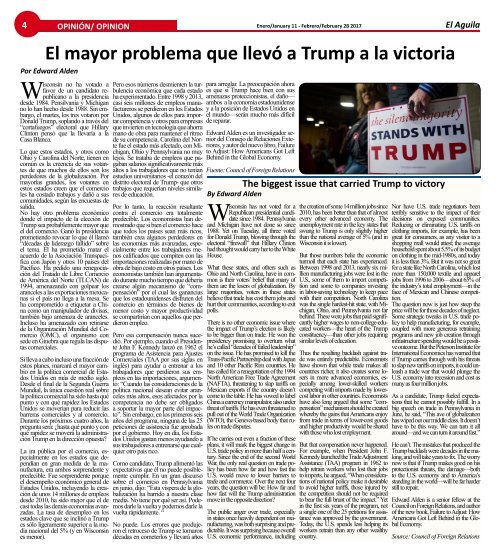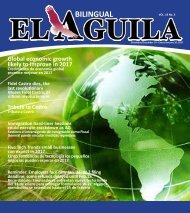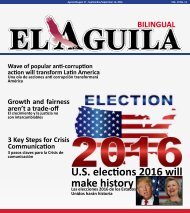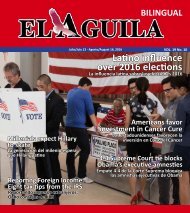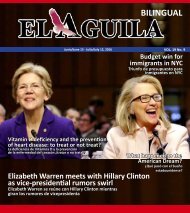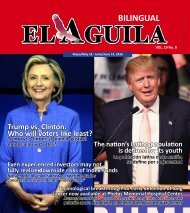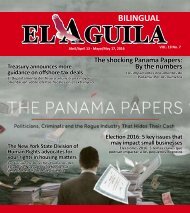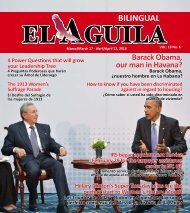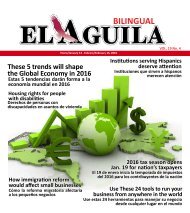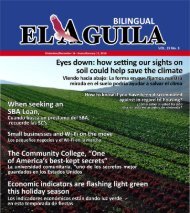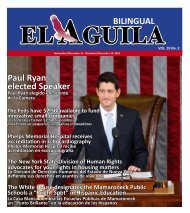El Aguila Magazine – January 11, 2017
You also want an ePaper? Increase the reach of your titles
YUMPU automatically turns print PDFs into web optimized ePapers that Google loves.
4 OPINIÓN/ OPINION Enero/<strong>January</strong> <strong>11</strong> - Febrero/February 28 <strong>2017</strong> <strong>El</strong> <strong>Aguila</strong><br />
<strong>El</strong> mayor problema que llevó a Trump a la victoria<br />
Por Edward Alden<br />
Wisconsin no ha votado a<br />
favor de un candidato republicano<br />
a la presidencia<br />
desde 1984. Pensilvania y Michigan<br />
no lo han hecho desde 1988. Sin embargo,<br />
el martes, los tres votaron por<br />
Donald Trump, soplando a través del<br />
“cortafuegos” electoral que Hillary<br />
Clinton pensó que la llevaría a la<br />
Casa Blanca.<br />
Lo que estos estados, y otros como<br />
Ohio y Carolina del Norte, tienen en<br />
común es la creencia de sus votantes<br />
de que muchos de ellos son los<br />
perdedores de la globalización. Por<br />
mayorías grandes, los votantes en<br />
estos estados creen que el comercio<br />
les ha costado trabajos y dañó a sus<br />
comunidades, según las encuestas de<br />
salida.<br />
No hay otro problema económico<br />
donde el impacto de la elección de<br />
Trump sea probablemente mayor que<br />
el del comercio. Ganó la presidencia<br />
prometiendo revocar lo que él llamó<br />
“décadas de liderazgo fallido” sobre<br />
el tema. Él ha prometido matar el<br />
acuerdo de la Asociación Transpacífica<br />
con Japón y otros 10 países del<br />
Pacífico. Ha pedido una renegociación<br />
del Tratado de Libre Comercio<br />
de América del Norte (TLCAN) de<br />
1994, amenazando con golpear los<br />
aranceles a las exportaciones mexicanas<br />
si el país no llega a la mesa. Se<br />
ha comprometido a etiquetar a China<br />
como un manipulador de divisas,<br />
también bajo amenaza de aranceles.<br />
Incluso ha amenazado con retirarse<br />
de la Organización Mundial del Comercio<br />
(OMC), el organismo con<br />
sede en Ginebra que regula las disputas<br />
comerciales.<br />
Si lleva a cabo incluso una fracción de<br />
estos planes, marcará el mayor cambio<br />
en la política comercial de Estados<br />
Unidos en más de medio siglo.<br />
Desde el final de la Segunda Guerra<br />
Mundial, la única cuestión real sobre<br />
la política comercial ha sido hasta qué<br />
punto y con qué rapidez los Estados<br />
Unidos se moverían para reducir las<br />
barreras comerciales y al comercio.<br />
Durante los próximos cuatro años, la<br />
pregunta será: ¿hasta qué punto y con<br />
qué rapidez se moverá la administración<br />
Trump en la dirección opuesta?<br />
La ira pública por el comercio, especialmente<br />
en los estados que dependían<br />
en gran medida de la manufactura,<br />
era ambos sorprendente y<br />
predecible. Fue sorprendente porque<br />
el desempeño económico general de<br />
Estados Unidos, incluyendo la creación<br />
de unos 14 millones de empleos<br />
desde 2010, ha sido mejor que el de<br />
casi todas las demás economías avanzadas.<br />
La tasa de desempleo en los<br />
estados clave que se inclinó a Trump<br />
es sólo ligeramente superior a la media<br />
nacional del 5% (y en Wisconsin<br />
es menor).<br />
Pero esos números desmienten la turbulencia<br />
económica que cada estado<br />
ha experimentado. Entre 1998 y 2013,<br />
casi seis millones de empleos manufactureros<br />
se perdieron en los Estados<br />
Unidos, algunos de ellos para importar<br />
competencia y otros para empresas<br />
que invierten en tecnología que ahorra<br />
mano de obra para mantener el ritmo<br />
de su competencia. Carolina del Norte<br />
fue el estado más afectado, con Michigan,<br />
Ohio y Pennsylvania no muy<br />
lejos. Se trataba de empleos que pagaban<br />
salarios significativamente más<br />
altos a los trabajadores que no tenían<br />
estudios universitarios -el corazón del<br />
distrito electoral de Trump- que otros<br />
trabajos que requerían niveles similares<br />
de educación.<br />
Por lo tanto, la reacción resultante<br />
contra el comercio era totalmente<br />
predecible. Los economistas han demostrado<br />
que si bien el comercio hace<br />
que todos los países sean más ricos,<br />
también crea algunos perdedores en<br />
las economías más avanzadas, especialmente<br />
entre los trabajadores menos<br />
calificados que compiten con las<br />
importaciones realizadas por mano de<br />
obra de bajo costo en otros países. Los<br />
economistas también han argumentado<br />
durante mucho tiempo que debería<br />
crearse algún mecanismo de “compensación”<br />
por el cual las ganancias<br />
que los estadounidenses disfruten del<br />
comercio en términos de bienes de<br />
menor costo y mayor productividad<br />
se compartirían con aquellos que perdieron<br />
empleo.<br />
Pero esa compensación nunca sucedió.<br />
Por ejemplo, cuando el Presidente<br />
John F. Kennedy lanzó en 1962 el<br />
programa de Asistencia para Ajustes<br />
Comerciales (TAA por sus siglas en<br />
inglés) para ayudar a entrenar a los<br />
trabajadores que perdieron sus empleos<br />
en las importaciones, argumentó:<br />
“Cuando las consideraciones de la<br />
política nacional desean evitar aranceles<br />
más altos, esos afectados por la<br />
competencia no debe ser obligados<br />
a soportar la mayor parte del impacto”.<br />
Sin embargo, en los primeros seis<br />
años del programa, ninguna de las 25<br />
peticiones de asistencia fue aprobada<br />
por el gobierno. Hoy en día, los Estados<br />
Unidos gastan menos ayudando a<br />
sus trabajadores a entrenarse que cualquier<br />
otro país rico.<br />
Como candidato, Trump alimentó las<br />
expectativas que él no puede posiblemente<br />
cumplir. En un gran discurso<br />
sobre el comercio en Pennsylvania<br />
en junio, dijo: “Esta víspera de la globalización<br />
ha barrido a nuestra clase<br />
media. No tiene por qué ser así. Podemos<br />
darle la vuelta y podemos darle la<br />
vuelta rápidamente. “<br />
No puede. Los errores que produjeron<br />
el retroceso de Trump se tomaron<br />
décadas en cometerlos y llevará años<br />
para arreglar. La preocupación ahora<br />
es que si Trump hace bien con sus<br />
amenazas proteccionistas, el daño—<br />
ambos a la economía estadounidense<br />
y a la posición de Estados Unidos en<br />
el mundo—serán mucho más difícil<br />
de reparar.<br />
Edward Alden es un investigador senior<br />
del Consejo de Relaciones Exteriores,<br />
y autor del nuevo libro, Failure<br />
to Adjust: How Americans Got Left<br />
Behind in the Global Economy.<br />
Fuente: Council of Foreign Relations<br />
By Edward Alden<br />
The biggest issue that carried Trump to victory<br />
Wisconsin has not voted for a<br />
Republican presidential candidate<br />
since 1984. Pennsylvania<br />
and Michigan have not done so since<br />
1988. Yet on Tuesday, all three voted<br />
for Donald Trump, blowing through the<br />
electoral “firewall” that Hillary Clinton<br />
had thought would carry her to the White<br />
House.<br />
What these states, and others such as<br />
Ohio and North Carolina, have in common<br />
is their voters’ belief that many of<br />
them are the losers of globalization. By<br />
large majorities, voters in these states<br />
believe that trade has cost them jobs and<br />
hurt their communities, according to exit<br />
polls.<br />
There is no other economic issue where<br />
the impact of Trump’s election is likely<br />
to be bigger than on trade. He won the<br />
presidency promising to overturn what<br />
he’s called “decades of failed leadership”<br />
on the issue. He has promised to kill the<br />
Trans-Pacific Partnership deal with Japan<br />
and 10 other Pacific Rim countries. He<br />
has called for a renegotiation of the 1994<br />
North American Free Trade Agreement<br />
(NAFTA), threatening to slap tariffs on<br />
Mexican exports if the country doesn’t<br />
come to the table. He has vowed to label<br />
China a currency manipulator, also under<br />
threat of tariffs. He has even threatened to<br />
pull out of the World Trade Organization<br />
(WTO), the Geneva-based body that rules<br />
on trade disputes.<br />
If he carries out even a fraction of these<br />
plans, it will mark the biggest change in<br />
U.S. trade policy in more than half a century.<br />
Since the end of the second World<br />
War, the only real question on trade policy<br />
has been how far and how fast the<br />
U.S. would move to lower barriers to<br />
trade and commerce. Over the next four<br />
years, the question will be: How far and<br />
how fast will the Trump administration<br />
move in the opposite direction?<br />
The public anger over trade, especially<br />
in states once heavily dependent on manufacturing,<br />
was both surprising and predictable.<br />
It was surprising because overall<br />
U.S. economic performance, including<br />
the creation of some 14 million jobs since<br />
2010, has been better than that of almost<br />
every other advanced economy. The<br />
unemployment rate in the key states that<br />
swung to Trump is only slightly higher<br />
than the national average of 5% (and in<br />
Wisconsin it is lower).<br />
But those numbers belie the economic<br />
turmoil that each state has experienced.<br />
Between 1998 and 2013, nearly six million<br />
manufacturing jobs were lost in the<br />
U.S., some of them to import competition<br />
and some to companies investing<br />
in labor-saving technology to keep pace<br />
with their competition. North Carolina<br />
was the single hardest-hit state, with Michigan,<br />
Ohio, and Pennsylvania not far<br />
behind. These were jobs that paid significantly<br />
higher wages to non-college-educated<br />
workers—the heart of the Trump<br />
constituency—than other jobs requiring<br />
similar levels of education.<br />
Thus the resulting backlash against trade<br />
was entirely predictable. Economists<br />
have shown that while trade makes all<br />
countries richer, it also creates some losers<br />
in more advanced economies, especially<br />
among lower-skilled workers<br />
competing with imports made by lowercost<br />
labor in other countries. Economists<br />
have also long argued that some “compensation”<br />
mechanism should be created<br />
whereby the gains that Americans enjoy<br />
from trade in terms of lower-cost goods<br />
and higher productivity would be shared<br />
with those who lost employment.<br />
But that compensation never happened.<br />
For example, when President John F.<br />
Kennedy launched the Trade Adjustment<br />
Assistance (TAA) program in 1962 to<br />
help retrain workers who lost their jobs<br />
to imports, he argued, “When considerations<br />
of national policy make it desirable<br />
to avoid higher tariffs, those injured by<br />
the competition should not be required<br />
to bear the full brunt of the impact.” Yet<br />
in the first six years of the program, not<br />
a single one of the 25 petitions for assistance<br />
was approved by the government.<br />
Today, the U.S. spends less helping its<br />
workers retrain than any other wealthy<br />
country.<br />
Nor have U.S. trade negotiators been<br />
terribly sensitive to the impact of their<br />
decisions on exposed communities.<br />
Reducing or eliminating U.S. tariffs on<br />
clothing imports, for example, has been<br />
great for consumers, as any visitor to a<br />
shopping mall would attest; the average<br />
household spent about 5.5% of its budget<br />
on clothing in the mid-1980s, and today<br />
it is less than 3%. But it was not so great<br />
for a state like North Carolina, which lost<br />
more than 150,000 textile and apparel<br />
jobs from 1996 to 2006—about 65% of<br />
the industry’s total employment—in the<br />
face of Mexican and Chinese competition.<br />
The question now is just how steep the<br />
price will be for those decades of neglect.<br />
Some strategic tweaks in U.S. trade policy<br />
to help manufacturing, for example,<br />
coupled with more generous retraining<br />
programs and new job creation through<br />
infrastructure spending would be a positive<br />
outcome. But the Peterson Institute for<br />
International Economics has warned that<br />
if Trump carries through with his threats<br />
to slap new tariffs on imports, it could unleash<br />
a trade war that would plunge the<br />
U.S. economy into recession and cost as<br />
many as four million jobs.<br />
As a candidate, Trump fueled expectations<br />
that he cannot possibly fulfill. In a<br />
big speech on trade in Pennsylvania in<br />
June, he said, “This ave of globalization<br />
has wiped out our middle class. It doesn’t<br />
have to be this way. We can turn it all<br />
around—and we can turn it around fast.”<br />
He can’t. The mistakes that produced the<br />
Trump backlash were decades in the making,<br />
and will take years to fix. The worry<br />
now is that if Trump makes good on his<br />
protectionist threats, the damage—both<br />
to the U.S. economy and to America’s<br />
standing in the world—will be far harder<br />
still to repair.<br />
Edward Alden is a senior fellow at the<br />
Council on Foreign Relations, and author<br />
of the new book, Failure to Adjust: How<br />
Americans Got Left Behind in the Global<br />
Economy.<br />
Source: Council of Foreign Relations


